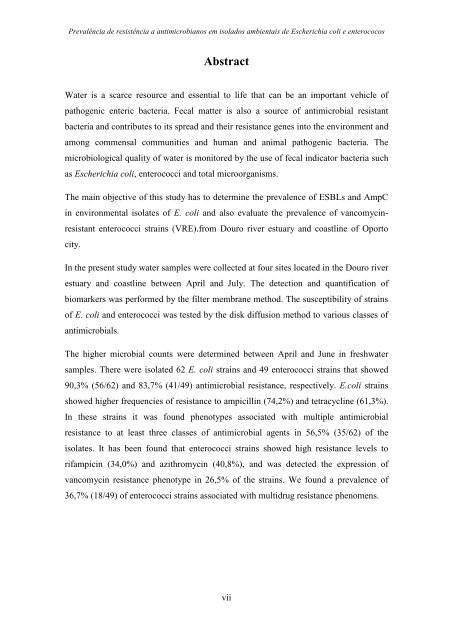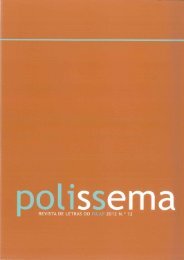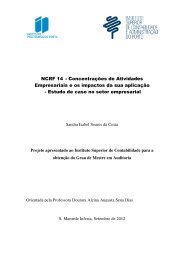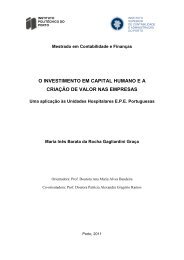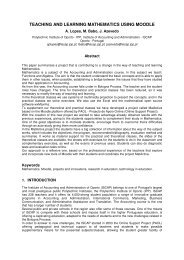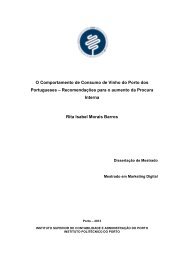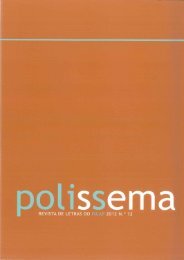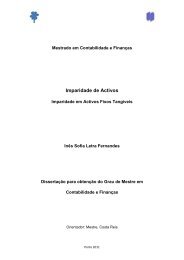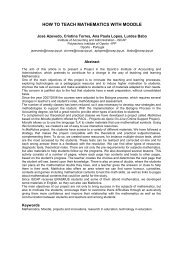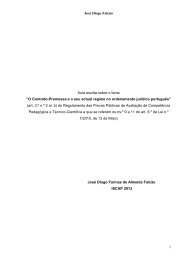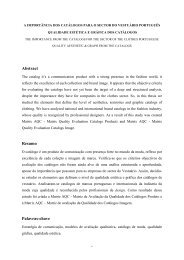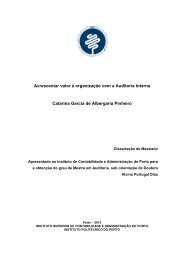Prevalência de resistência a antimicrobianos em isolados ...
Prevalência de resistência a antimicrobianos em isolados ...
Prevalência de resistência a antimicrobianos em isolados ...
Create successful ePaper yourself
Turn your PDF publications into a flip-book with our unique Google optimized e-Paper software.
<strong>Prevalência</strong> <strong>de</strong> <strong>resistência</strong> a <strong>antimicrobianos</strong> <strong>em</strong> <strong>isolados</strong> ambientais <strong>de</strong> Escherichia coli e enterococos<br />
Abstract<br />
Water is a scarce resource and essential to life that can be an important vehicle of<br />
pathogenic enteric bacteria. Fecal matter is also a source of antimicrobial resistant<br />
bacteria and contributes to its spread and their resistance genes into the environment and<br />
among commensal communities and human and animal pathogenic bacteria. The<br />
microbiological quality of water is monitored by the use of fecal indicator bacteria such<br />
as Escherichia coli, enterococci and total microorganisms.<br />
The main objective of this study has to <strong>de</strong>termine the prevalence of ESBLs and AmpC<br />
in environmental isolates of E. coli and also evaluate the prevalence of vancomycin-<br />
resistant enterococci strains (VRE).from Douro river estuary and coastline of Oporto<br />
city.<br />
In the present study water samples were collected at four sites located in the Douro river<br />
estuary and coastline between April and July. The <strong>de</strong>tection and quantification of<br />
biomarkers was performed by the filter m<strong>em</strong>brane method. The susceptibility of strains<br />
of E. coli and enterococci was tested by the disk diffusion method to various classes of<br />
antimicrobials.<br />
The higher microbial counts were <strong>de</strong>termined between April and June in freshwater<br />
samples. There were isolated 62 E. coli strains and 49 enterococci strains that showed<br />
90,3% (56/62) and 83,7% (41/49) antimicrobial resistance, respectively. E.coli strains<br />
showed higher frequencies of resistance to ampicillin (74,2%) and tetracycline (61,3%).<br />
In these strains it was found phenotypes associated with multiple antimicrobial<br />
resistance to at least three classes of antimicrobial agents in 56,5% (35/62) of the<br />
isolates. It has been found that enterococci strains showed high resistance levels to<br />
rifampicin (34,0%) and azithromycin (40,8%), and was <strong>de</strong>tected the expression of<br />
vancomycin resistance phenotype in 26,5% of the strains. We found a prevalence of<br />
36,7% (18/49) of enterococci strains associated with multidrug resistance phenomens.<br />
vii


